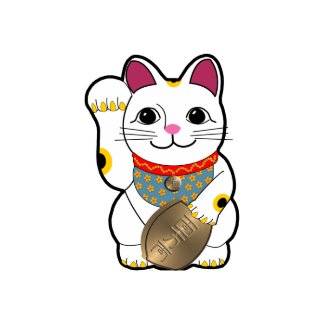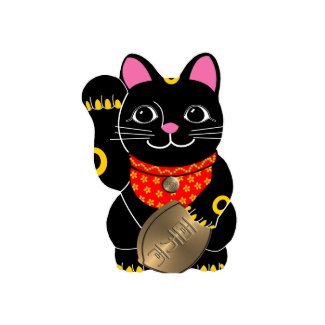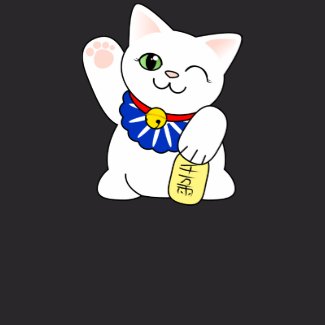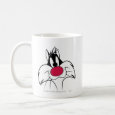If you’re not Chinese or Japanese, you may not have heard the term “maneki neko” but you may well have seen one; most probably in a Chinese or Japanese restaurant or shop. Maneki neko is a good luck charm in the form of a cat figurine that has one paw raised in what looks like a kind of wave. It’s often nicknamed “the lucky waving cat”. Why would a waving cat be lucky?
Maneki neko meaning:
Although it is often mistaken for a wave, this lucky cat is actually not waving. It’s designed to be beckoning. The meaning of “Maneki neko” in Japanese is “beckoning cat”. Some believe that the higher its paw, the more luck the cat beckons in.
What kind of luck is this beckoning cat supposed to bring?
The kind of luck the maneki neko is said to bring depends on which paw it is holding up, and also depending on the cat’s color.
Luck brought depending on which paw is raised:
People differ in their interpretation but generally the following is believed:
- Left paw raised: This is thought to bring luck in the form of beckoning in people, such as guests or more customers for your business.
- Right paw raised: This is believed to beckon in good luck, particularly in money and wealth. For this reason, some maneki neko sculptures have been made into hollow statues with coin slots in them, serving as piggy banks.
Luck brought depending on maneki neko colors:
- White maneki neko often with tricolor spots or patches: This is considered to bring pure good luck because tricolor cats are not an everyday occurrence, much like good luck.
- Black maneki neko color: This is thought to ward off evil and disease.
- Gold maneki neko color: This is believed to invite in money and wealth.
Why is this beckoning cat sculpture thought to be lucky?
There are many stories about why beckoning cat sculptures became popular. No-one knows the exact true origins, but it is known that it arose in Japan around the 1800s. This is confirmed by the bib it wears which was common cat adornment in wealthier homes in the Edo Period (1603-1867). The following are the most popular stories about the maneki neko origins:
Story 1: Maneki Neko are in Honor of a Cat who Saved a Japanese nobleman’s life
This story is that a nobleman was going for a stroll and was deep in thought when he noticed a movement at the side of his eye. He stopped in his tracks to see what the movement was and saw a cat on the side of the road apparently beckoning him towards it with its paw. Curious, the nobleman approached the cat. When he returned to the road, he noticed a trap had been laid out for him and he thought to himself: “Had I not been shaken from my thoughts by this remarkable beckoning cat, I would not have noticed the trap! I owe this cat my life!” In honor of this cat, he made a beckoning cat figurine which he said was a wise and lucky figurine to keep.
Another version of this story is that rather than a trap, it was lightning from which a nobleman was saved. This story goes that a lord was visiting the Gotoku-ji Temple in Japan during a thunderstorm and he was taking refuge from the rain under a tree. He saw the temple cat seeming to beckon him with his paw, and as the lord went to investigate, the tree he had been standing underneath a moment earlier got struck by lightning. In gratitude for this temple cat that saved his life, the wealthy lord gave lots of money to the temple and he commissioned that cat decorations be painted on the temple walls. To this day the Goutoku-ji Temple houses cat paintings and sculptures and even contains a cat cemetery. When the cat eventually died the lord ordered a sculpture of a beckoning cat to be made which was to be considered lucky. This figurine became associated not only with luck but also with the lord’s wealth.
Story 2: Maneki Neko are an extension of an older superstition about cats washing their faces
Some suggest that there is an ancient Japanese superstition derived from an old Chinese proverb that says that when a cat is seen to be washing its face, it means it will rain soon. This evolved into a belief that when a cat raises its paw to wash its face it will “rain” people upon you like guests and customers. Customers bring wealth and are therefore good luck. So the raised hand of the maneki neko may be a hand raised in face-wash action.
Story 3: Maneki Neko brought wealth to its creator and therefore bring luck and prosperity
This story goes that the first Maneki Neko was made by a poor old woman who was so poor she could no longer keep her beloved cat. Soon after she gave up her cat, he came to her in a dream, telling her to make a sculpture of him in clay. This she did, and soon people expressed interest in buying her creation. She sold it and made more until eventually the cat sculpture made her extremely wealthy. Ever since then, the Maneki neko was believed to bring prosperity to all who had one.
Story 4: Maneki Neko are in honor of a cat who saved a woman from a snake
This is perhaps one of the most widely told stories about the maneki neko. This story is about a geisha called Usugumo who had a pet cat she loved dearly. One night as the geisha-house owner passed by Usugumo, her cat became frenetic and feverishly began pulling at Usugumo’s kimono. Alarmed and thinking the cat to be possessed, the geisha-house owner took a nearby sword and decapitated the cat. Not a great story for the cat… but the cat’s head flew through the air, hitting a snake which had been curled up on the ceiling, poised to strike at Usugumo’s head. It seemed the cat may have been warning Usugumo and as its final dutiful act to its owner, it saved her from this poisonous snake. Distraught by the death of her cat, a customer sought to cheer her up by making her a sculpture of her lucky cat that had saved her life.
Although this story may sound a bit strange, Usugumo indeed lived around the time when the first maneki neko appeared and it is believed that the first maneki nekos were seen in geisha houses.
Related Articles
- Why is the rabbit’s foot lucky?
- For other cultural articles click here: Cultural articles
Related Products












Pingback: Nando’s Chicken and the Portuguese Rooster